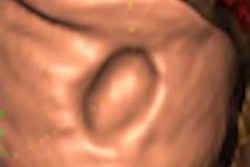Intraductal papillary mucinous neoplasms (IPMNs) are a tricky finding on pancreatic CT imaging studies. As one of the few surgically curable pancreatic tumors, IPMNs can evolve through several biological stages, ranging from slight dysplasia to carcinoma. But IPMNs are easy to miss on CT when tumors are small and the scan technique is suboptimal, and they are difficult to characterize as malignant or benign.
But new research from Shanghai combines MDCT with CT angiography (CTA) and multiplanar volume or curved reformations to characterize IPMNs with high sensitivity. The study, published in the World Journal of Gastroenterology, addresses MDCT's role in predicting malignancy of IPMNs preoperatively.
A research team led by Dr. Den-Bin Wang from Ruijin Hospital and Jiao Tong University School of Medicine examined 20 patients with pathologically proven IPMNs. Axial MDCT images combined with CTA and multiplanar volume or curved reformations were created from the image data. Two radiologists evaluated all images and determined findings in consensus (World J Gastroenterol, August 28, 2009, Vol. 15:32, pp. 4037-4043).
Pathology confirmed 12 malignant and eight benign IPMNs. The researchers found the diameters of the cystic lesions and main pancreatic ducts to be significantly larger in malignant IPMNs compared with benign findings (p < 0.05). There was also a higher incidence of malignancy in the combination-type IPMN compared to two other types (p < 0.05).
IPMNs containing mural nodules and thick septa had a significantly higher rate of malignancy than other tumors (p < 0.05). Communication of side-branch IPMNs with the main pancreatic duct was seen in just nine cases at pathologic examination, of which seven were identified on CTA and multiplanar volume or curved reformation images, Wang and colleagues reported.
Compared to the diagnosis at pathology, MDCT's sensitivity, specificity, and accuracy in characterizing the malignancy of IPMNs of the pancreas were 100%, 87.5%, and 95%, respectively.
MDCT imaging with CTA and multiplanar volume or curved reformatted reconstructions can reveal the unique imaging features of IPMNs and help predict their malignancy, the authors concluded.
Related Reading
Ultrasound screens for pancreatic cancer in high-risk populations, January 19, 2009
MDCT identifies malignant pancreatic cysts for surgery, August 20, 2008
CT rules out malignancy in most pancreatic cysts, June 9, 2008
Ultrasound of the pancreas: Cystic and non-focal pathology, February 13, 2004
Focal solid lesions of the pancreas, October 14, 2003
Copyright © 2009 AuntMinnie.com




















